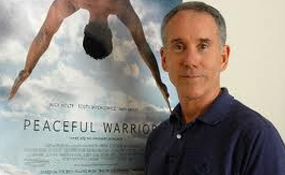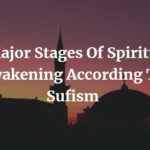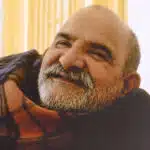by Dan Millman: We may understand the journey; we may even have a sound vehicle; but on any journey—whether through athletics or in daily life we need sufficient emotional fuel to get moving.

Different from physical-vital energy, emotional energy creates the feeling impulse to move toward our goals; we call it motivation. When emotional energy flows through us freely, without obstructions, we feel naturally motivated. There is no force more powerful than a motivated human being We’ve all heard success stories about underdogs who produced miracles from the stuff of motivation. Motivation serves as a key to any process of training and beats at the heart of emotional talent.
Nothing great was ever achieved
without enthusiasm.—Ralph Waldo Emerson
Inspiration and motivation can make the difference between victory and defeat, success and failure, or even life and death. The energy derived from motivation carries distance runners past the “wall of pain” when their physical energy reserves are exhausted. On the other hand, strapping athletes bursting with vital physical energy who lack a directed emotional impulse to strive for their goals may wander aimlessly and arrive nowhere in particular.
We all appreciate the importance of self discipline but think of discipline as doing what we don’t really feel like doing. With sufficient motivation, we’re so inspired that we don’t even think about discipline. As a young gymnast, for example, I was so inspired and excited that I trained six days a week for more than four hours a day for years and never felt as if I were “working” or that I needed discipline. They key for me was to keep my eye on the shining goal that inspired me.
Once released, the power of emotional energy can work magic: It smothers fear and steam rolls over obstacles. An obstacle is just something we worry about when we’ve taken our eyes off the goal.
I’ve seen athletes who were long-shots develop into national champions through directed emotional energy. Eric, a teammate of mine, had had polio as a child. His legs were so atrophied that when I first saw him he had to walk with braces or on crutches. He became a specialist on the rings. He simply worked harder than anyone. It wasn’t enough to develop superior strength; he also began to practice a dismount from the rings that took him about nine feet in the air. He performed a full-twisting somersault and, by some incredible feat of will, landed unassisted on those spindly legs. Over and over I’d see him crash to the floor. His brother told me he used to go home and cry, the pain in his legs was so intense. After three years, Eric was able to run around the gym without leg braces, and he placed second in the national championships.
In daily life, little tasks that require only a modest amount of energy do not require great motivation for their completion. The world of athletics, however, demands much more of us.
Most of us relate to motivation passively, as if it were something that descends upon us without our control. We might feel motivated on one day but not on another day. The message of this chapter is that all the motivational energy we’ll ever need is within us.
Emotional talent is the capacity to stimulate and draw upon one’s natural fountain of energy. Developing emotional talent is learning to blow into our own sails.
When we speak of emotions, we often refer to “positive” emotions like joy, serenity, and elation, and “negative” emotions like fear, sorrow, or anger. The latter are not true emotions at all but emotional obstructions that block the free and natural flow of motivation. To understand this better, let’s look beck to our infancy:
When we were babies, motivation was natural to us, and it was constant, for everything was interesting to us. On occasion we might have tensed our little bodies and cried, but crying was a simple, natural response to physical discomfort, not complex mental concerns. Our general state was a clear mind and relaxed body. Our minds and bodies were in their natural relationship—mind free of thought, in a state of clarity, focus, and attention; body free of tension, full of feeling, sensitivity, and vitality. We experienced the state of pure energy—motivation—fuel for action, the impulse to move, to explore, to grow.
As we grew and became more aware of the rules, meanings, and demands of the world, we began to feel a separation from the protected cradle of infancy. Vulnerable to a world of emotional turbulence, social turmoil, and human frustration, we began to know guilt, fear, and anxiety. We learned to dam up our emotions so that we didn’t feel bad; in fact, we didn’t feel much at all. As minds become depositories of traumatic memories, bodies begin to store tension. We experience this tension as a cramp in the chest or abdominal region, but also in the lower back, neck, jaws, and some other body parts. The name of this tension, which we can observe in ourselves in times of stress, is emotion. But the feeling we call “emotional” is most often a blockage of emotional energy. Because that energy is blocked, much as water flowing through a hose might be blocked, we feel pressure at the points of tension.
The energy gathers in knots, taking shape as what we call anger or fear or sorrow, depending upon what thoughts stimulated that tension. Emotional blocks (or tension) are reactions to thoughts. If you’re standing in line at the bank and someone butts in front of you, you may immediately “feel angry.” Infants don’t become upset by someone butting in line because they haven’t yet incorporated society’s responses to such an action. But you have learned that “people should wait their proper turn in line.” Perhaps true enough, socially. Yet it is such meanings that stimulate emotional reactions. Only the mind free of meanings and judgments and expectations can allow the free flow of emotional energies—free of reactions of fear, sorrow, and anger.
Fear, sorrow, and anger are the three primary emotional obstructions, and like the three primary colors they combine to form a wide spectrum of such emotional hues as impatience, frustration, melancholy, and anxiety.
Fear, sorrow, and anger are normal, but they are not inevitable emotional reactions to perceived stress. Infants may cry from physical discomfort but they am naturally free the complex mental structures that often result in emotional tension.
Inner athletes do not deny or repress their feelings, but they learn to stay relaxed even under stressful conditions.
As it happens, it is very difficult to “feel” angry, fearful, and sorrowful if we breathe evenly and fully and we keep the body relaxed. Emotional upsets are inevitably associated with a tension in the chest or abdomen; by keeping relaxed and focusing on our breathing, we short-circuit the tension-producing stress. That allows us to express ourselves, or act, far more effectively.
If, for example, a growling dog jumps out at us with its teeth bared, it may be appropriate for us to freeze, run, growl back, or climb the nearest telephone pole. We can perform any of these natural reactions immediately, without the reactive tension we interpret as fear. And, in fact, such tension will only serve to delay the appropriate response.
It’s healthy to express sorrow or anger or fear. But tension emotional or otherwise is not useful to the body. Its debilitating effects on blood circulation, muscle response, and the immune system have been well documented.
Breaking the Circuit of Tension
We have seen that the mind imposes tension on the body and is the source of emotional turmoil. But until we master the mind, how do we break the harmful circuit of mental stress that becomes emotional and physical tension?
Follow this technique to regain emotional equanimity:
Undoing emotional habits formed over the years isn’t easy, but we can do it. In any moment, you have the capacity to breathe deeply, relax, and let go. Allow rather than resist what arises inside or out in the present moment. Let it be interesting rather than “good” or “bad.” In this way, we reawaken true emotion, the energy to act. |
Breath and Feeling
“Inspiration,” in addition to its usual connotation, also means to breathe in. The breath is a key to your emotional state because it both reflects and can control your level of tension. Learning to breathe properly, with full feeling, gives you the ability quite literally to “inspire” yourself. The natural athlete, like the infant, breathes naturally, from deep in the body, with slow, full, relaxed, and balanced inhalations and exhalations.
To understand your emotional state and to gain mastery over emotions, it’s essential that you begin to observe and gain conscious control over your breathing. Breath awareness and discipline were central to the teachings of the most ancient spiritual traditions. Yogis, Zen masters, and martial artists have all placed great emphasis on breathing properly.
The one unifying link between mind and body is the breath. Meditation deals with the mind but could also be called a physical relaxation exercise. Relaxation exercises, in turn, deal with the body but could also be called meditation exercises. Both body and mind are intimately related to the emotions through awareness of the breath. The various approaches to well-being demonstrate the intimate relationship of the three centers: physical, mental, and emotional. Meditation practices center around insight and release of thought. As thoughts are released, emotions flow naturally, and the body relaxes. Coming from another direction, you can emphasize relaxation of the body. As the body relaxes, the mind tends to become quiet as well, and the emotions open. All the various approaches to well-being are only ways to reawaken the natural athlete within us.
If you were to observe your breathing for a few hours during the day, you would notice periods of fitful breathing, with starts and stops, holding of the breath, tension in the chest area, limiting the breathing to shallow gulps of air in the upper chest. If you studied your breathing – and that of others over a long period of time- you would see that the three primary emotional obstructions, sorrow, and fear – are each characterized by an imbalance in breathing. Anger is reflected by weak inhalation and forceful, exaggerated exhalation. Sorrow (as in sobbing) is characterized by spasmodic, fitful inhalation and weak exhalation. Fear can result in very little breathing at all. As you develop awareness of your breathing patterns through conscious intent, you can become responsible for the recognition of reactive patterns as error and can then use the breath as a key method of balancing body, mind, and emotions.
The following exercise will give you a feeling for proper breathing and its effect on the body:
Sit comfortably, either on a chair or on a cushion. The spine should be upright but not stiff.
Tension breathing. For a few minutes, breathe with the shoulders raised upward; breathe using the upper chest only; take shallow breaths. Experience how this feels.
Natural breathing. Relax the shoulders by lifting and dropping them a few times, until they just hang. Feel their weight. Keep the mouth closed, the chin tucked gently in, and the eyes closed.
Breathe slowly and deeply, but without any sense of strain. When you inhale, feel your belly draw downward and slightly outward. When you exhale, let the belly relax back up and in. Do this for at least ten minutes, remembering to relax the shoulders, to keep the mouth closed, to notice the rise and fall of the belly. Experience what natural breathing feels like.
As natural breathing becomes more natural for you, you can apply it to your athletic play and your everyday activities. Your breathing will soon be more conscious and timed rhythmically to the force and rhythm of your movements, giving them grace and ease. Ultimately, you will feel that your breath moves your body, freeing you from unnecessary muscular effort. Whenever you notice that you feel tense, just focus your attention on feeling the pleasure of slow, deep, relaxed breathing. Let the shoulders hang. In a few moments, you’ll feel the change. Controlling the breath is but one of the ways we can exercise control over emotional reactivity—not by repressing but by transcending.
The Inner Witness
The law of accommodation reminds us that “life develops what it demands.” The corollary of that principle says what is not used becomes obsolete. On the physical level, for example, if we don’t use a muscle, it atrophies becomes weak It’s the same for reactive emotional habit patterns; through non use, we make them obsolete.
Witnessing is a learned skill consisting of recognition and release of old patterns. If we notice anger, we acknowledge it and release it.
It may seem strange, but we can feel good physically in spite of whatever negative thoughts or emotions arise. Negative thoughts don’t have to mean negative tension-if are willing to let go of them. That is the essence of witnessing.
Acknowledging an emotional obstruction – “I’m afraid,” “I feel angry”)—is constructive, even essential for optimal health. But meditating on that obstruction, habitually dramatizing it, creates an unwelcome pattern.
Fear, anger, and sorrow, are part of life. We don’t make them go away by wishing it. But we do have the choice of ways we will respond.
We don’t have to bring a fearful thought or its corresponding tension to life; we don’t have to dramatize it. We may feel afraid, but we don’t have to act afraid. We don’t have to freeze or scream “Oh MY God!”!” We need not act out the role of someone who is afraid.
It’s not easy to refrain from dramatizing a reactive pattern.
But we can learn that it isn’t necessary to wait passively for fearful thoughts to go away or “get better,” nor is it necessary to wait for emotions to disappear before we learn to act rather than merely to react. All we need to do is change our actions. We can speak positively and act positively, whether we feel like it or not.
Inner athletes can’t afford to hang on to compulsive or reactive baggage. We don’t want to ignore, resist, or repress that baggage; it’s certainly not helpful to pretend we don’t feel its weight. But we can translate our responses into positive energy and action. Then start to experience motivation as our natural state in everything we do.
When we feel willing and eager
the gods join in.
AESCHYLUS
























































